Breaking into the IT field can seem daunting, but it’s one of the most rewarding and dynamic career paths available today. Whether you’re a student, a career-changer, or simply an enthusiast, there are countless ways to begin building your technical skills. This post gathers practical, hands-on tips that will lay a strong foundation in IT and help you discover your interests in this ever-evolving field. Let’s dive into key areas of technical practice to kick-start your journey.
1. Hardware Mastery: Build Confidence by Building a Computer
Take an old desktop apart and put it back together again. Upgrade components like RAM, install a new hard drive, or experiment with installing an operating system. If the computer already has a hard drive, use it as a secondary drive if there’s space in the case. Learning to build and troubleshoot hardware will give you the confidence to handle technical issues when they arise.
2. Networking Basics: Explore the Fun World of Routers
Flashing Firmware
Experiment with open-source firmware like DD-WRT, OpenWRT, or Tomato on an off-the-shelf router. Ensure your router’s hardware supports the firmware and test on a secondary router before using it as your primary one. Once comfortable, explore features like routing, DHCP, DNS, DDNS, port forwarding, VLANs, and filtering. For an advanced challenge, build a custom router using an old desktop and pfSense.
Wired vs. Wireless
Run wires between devices to understand physical networking. Compare latency and resiliency between wired and wireless networks. For a deeper dive, explore software-defined networking (SDN) to understand how networks operate on a larger scale.
3. Network Literacy: Learn to Read and Create Network Diagrams
Study existing network diagrams online to understand how devices connect and communicate. Join communities on Reddit or LinkedIn to discuss designs with professionals. Practice creating your own network diagrams using free tools like Draw.io. This skill will help you conceptualize and communicate network layouts effectively.
4. Web Development: Build Your First Web Server
Set up a web server using Apache or Nginx on a virtual machine, Raspberry Pi, or an old computer. Use it to experiment with HTML, CSS, PHP, or even share files across your home network. However, avoid making your server internet-facing until you fully understand the security implications. This exercise will teach you both technical and creative skills.
5. Operating Systems: Learn Linux
Start with a beginner-friendly distribution like Debian or Ubuntu, either in a virtual machine or on old hardware. Linux offers unparalleled insight into how computers work under the hood. Its simplicity, resource efficiency, and versatility make it an invaluable tool for IT professionals. You’ll gain hands-on experience with commands, scripting, and troubleshooting that translate to any OS.
6. Cybersecurity Foundations
Start with OSINT
Learn Open Source Intelligence (OSINT) to understand how publicly available information can be leveraged for security purposes. OSINT is practical, requires minimal tools, and builds a foundation for deeper security knowledge.
Build a Hacker’s Lab
Experiment with tools like Kali Linux and Metasploitable. Kali is a Linux distribution loaded with security tools, while Metasploitable serves as a safe environment to practice penetration testing. These skills will help you strengthen your homelab’s security and prepare for real-world challenges.
7. Search Smarter: Learn Google Dorking
Google Dorking uses search operators to uncover misconfigured servers, IoT devices, and potential vulnerabilities. While ethical boundaries must be respected, this skill will teach you how to identify and resolve security gaps in systems you manage.
8. Automation: Start Scripting
Learn to write scripts to automate everyday tasks. Bash scripting in Linux is an excellent starting point. By creating simple scripts, you’ll deepen your understanding of your operating system and discover the power of automation in IT workflows.
9. Programming: Solve Real Problems
Programming is an essential skill for IT professionals. Start small by solving problems in your daily work, such as automating repetitive tasks or creating a program to interact with APIs. Popular beginner-friendly languages like Python offer versatility and a wealth of learning resources. Choose a language that aligns with your goals and interests.
Conclusion: Take the First Step Today
The IT field is vast and offers endless opportunities to learn and grow. By diving into these areas, you’ll build a strong technical foundation, develop problem-solving skills, and discover what excites you most about IT. Start with one area, explore, and let curiosity guide you. The possibilities are endless!
